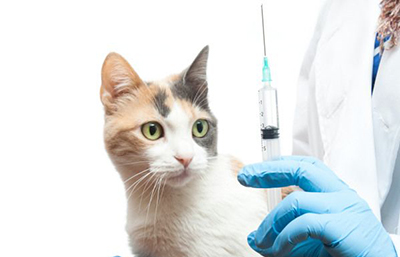Explaining the FVRCP in Feline Vaccines

Explaining the FVRCP in Feline Vaccines
June is Adopt a [Shelter] Cat Month and every blog post in June will focus on some aspect of our furry feline friends. Today’s topic is one of the “core” feline vaccinations, FVRCP.
Vaccines for cats are categorized as core and non-core. Core means veterinary infectious disease and public health experts recommend all cats receive vaccines considered core. Rabies vaccine is considered a core vaccine for both dogs and cats. The other core vaccine for cats is FVRCP or feline viral rhinotracheitis, calici virus, and panleukopenia. The rhinotracheitis virus and calicivirus are the top two causes of feline upper respiratory infections. The panleukopenia virus causes a severe viral diarrhea.
Basis for the Core Vaccine Designation
One of the reasons FVRCP is considered a core vaccine for cats is there are no specific treatments for feline viral rhinotracheitis, calcivirus or panleukopenia virus. The diseases must run their course and veterinarians can only treat symptoms: fluids for dehydration, antibiotics for secondary bacterial infections, eye ointments for corneal ulcers. It’s better to prevent these diseases with vaccination than to have your cat suffer from one of these debilitating viral infections. Should you fall in love with a shelter cat suffering from an upper respiratory infection due to rhinotracheitis virus and calicivirus, the cat is likely to make a full recovery and become a lovable member of the family.
The FVR
Feline viral rhinotracheitis is caused by a herpes virus. Similar to herpes virus infections in humans, once a cat is infected with a herpes virus, the virus will lay dormant until a cat is stressed and then clinical signs can flare up. Clinical signs of rhinotracheitis include lethargy, sneezing, conjunctivitis, and ocular and nasal discharge. Severe cases can have corneal ulcers and pneumonia. Young kittens are often the most severely affected.
The C
Feline calicivirus causes clinical signs similar to rhinotracheitis, but much milder. Cats with an upper respiratory infection due to calicivirus are likely to develop oral ulcers, especially of the tongue. Some cats develop joint inflammation leading to lameness but the lameness lasts only 1-2 days. Occasionally, a more virulent strain of calicivirus circulates in feline populations resulting in severe systemic disease.
The P
Panleukopenia is the medical way to say “a very low white blood cell count.” Closely related to the better known canine parvovirus, the feline panleukopenia virus infects the rapidly dividing cells of the bone marrow and intestinal tract. The impact on the bone marrow is a low white blood cell count which leaves panleukopenia virus-infected cats open to severe infection. Infection of the gut cells leads to severe diarrhea. Once a cat is infected with the panleukopenia virus, successfully treating this disease becomes very difficult. Fortunately, vaccination works well to prevent panleukopenia.
As part of your family’s celebration of June’s Adopt a [Shelter] Cat Month, check with your cat’s veterinarian about the need for FVRCP vaccination for your cat, the best type of vaccine and the schedule of administration.

































